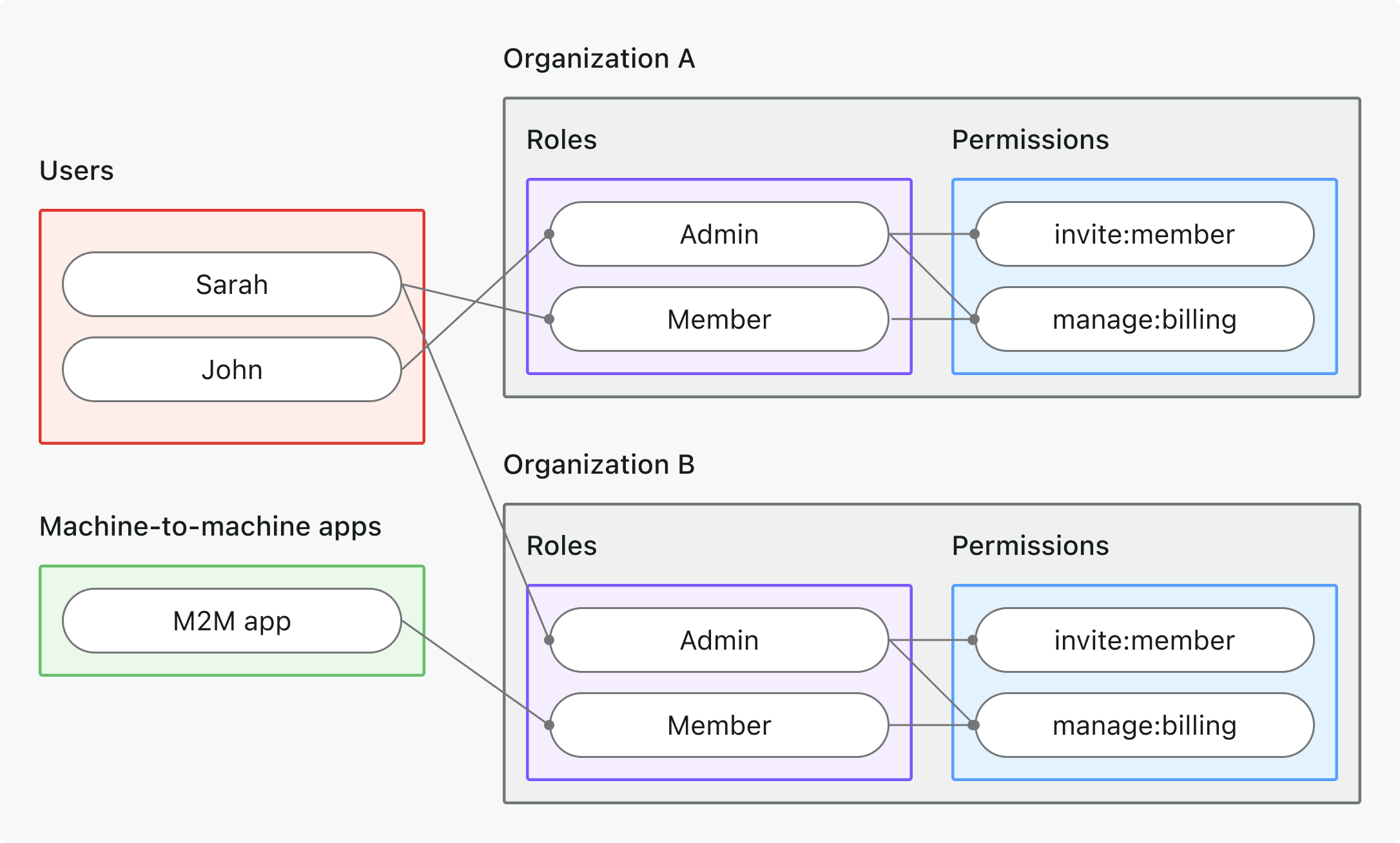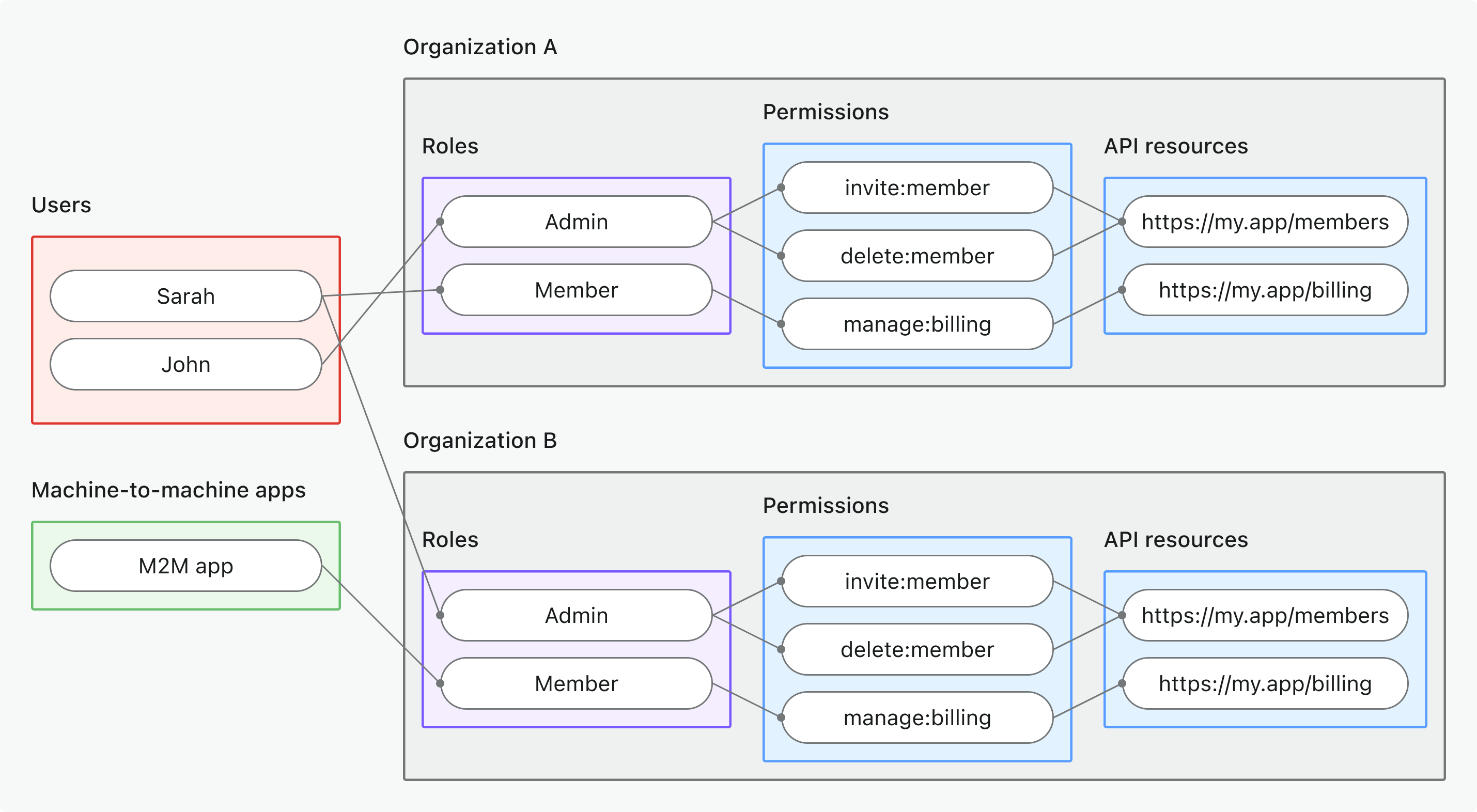使用 RBAC 與 JWT 驗證 (JWT validation) 保護你的 Quarkus API
本指南將協助你透過 角色型存取控制 (RBAC, Role-based access control) 以及由 Logto 簽發的 JSON Web Token (JWT) 實作授權 (Authorization),以保護你的 Quarkus API。
開始前
你的用戶端應用程式需要從 Logto 取得存取權杖 (Access tokens)。如果你尚未完成用戶端整合,請參考我們針對 React、Vue、Angular 或其他前端框架的 快速入門,或伺服器對伺服器存取請參閱 機器對機器指南。
本指南聚焦於在你的 Quarkus 應用程式中,對這些權杖進行伺服器端驗證。

你將學到
- JWT 驗證: 學習如何驗證存取權杖 (Access tokens) 並擷取驗證 (Authentication) 資訊
- 中介軟體實作: 建立可重複使用的中介軟體以保護 API
- 權限模型: 理解並實作不同的授權 (Authorization) 模式:
- 全域 API 資源 (Global API resources) 用於應用程式層級端點
- 組織權限 (Organization permissions) 控制租戶專屬功能
- 組織層級 API 資源 (Organization-level API resources) 用於多租戶資料存取
- RBAC 整合: 在 API 端點強制執行角色型權限 (Role-based permissions) 與權限範圍 (Scopes)
先決條件
- 已安裝最新版穩定版 Java
- 基本了解 Quarkus 與 Web API 開發
- 已設定 Logto 應用程式(如有需要請參閱 快速入門)
權限 (Permission) 模型總覽
在實作保護機制前,請先選擇最適合你應用程式架構的權限模型。這與 Logto 的三大授權 (Authorization) 情境相符:
- 全域 API 資源 (Global API resources)
- 組織(非 API)權限 (Organization (non-API) permissions)
- 組織層級 API 資源 (Organization-level API resources)

- 適用情境: 保護整個應用程式共用的 API 資源(非組織專屬)
- 權杖類型: 具有全域受眾 (global audience) 的存取權杖 (Access token)
- 範例: 公開 API、核心產品服務、管理端點
- 最適用於: 所有客戶共用 API 的 SaaS 產品、無租戶隔離的微服務架構
- 深入瞭解: 保護全域 API 資源

- 適用情境: 控制組織專屬的操作、UI 功能或商業邏輯(非 API)
- 權杖類型: 具有組織專屬受眾 (organization-specific audience) 的組織權杖 (Organization token)
- 範例: 功能開關、儀表板權限、成員邀請控制
- 最適用於: 具有組織專屬功能與流程的多租戶 SaaS
- 深入瞭解: 保護組織(非 API)權限

- 適用情境: 保護僅在特定組織情境下可存取的 API 資源
- 權杖類型: 具有 API 資源受眾 (API resource audience) + 組織情境 (organization context) 的組織權杖 (Organization token)
- 範例: 多租戶 API、組織範圍資料端點、租戶專屬微服務
- 最適用於: API 資料以組織為範圍的多租戶 SaaS
- 深入瞭解: 保護組織層級 API 資源
💡 請在繼續前選擇你的模型 —— 本指南後續內容將以你選擇的方式為參考。
快速準備步驟
設定 Logto 資源與權限 (Permissions)
- 全域 API 資源 (Global API resources)
- 組織(非 API)權限 (Organization (non-API) permissions)
- 組織層級 API 資源 (Organization-level API resources)
- 建立 API 資源 (API resource): 前往 Console → API 資源 (API resources) 並註冊你的 API(例如:
https://api.yourapp.com) - 定義權限 (Permissions): 新增如
read:products、write:orders等權限範圍 (Scopes) —— 參考 定義帶有權限的 API 資源 - 建立全域角色 (Global roles): 前往 Console → 角色 (Roles) 並建立包含 API 權限的角色 —— 參考 設定全域角色
- 指派角色 (Assign roles): 將角色指派給需要 API 存取權的使用者或 M2M 應用程式
- 定義組織權限 (Organization permissions): 在組織範本中建立如
invite:member、manage:billing等非 API 組織權限 - 設定組織角色 (Organization roles): 在組織範本中配置組織專屬角色並指派權限給這些角色
- 指派組織角色 (Assign organization roles): 在每個組織情境下將使用者指派到組織角色
- 建立 API 資源 (API resource): 如上註冊你的 API 資源,但將用於組織情境
- 定義權限 (Permissions): 新增如
read:data、write:settings等限定於組織情境的權限範圍 (Scopes) - 設定組織範本 (Configure organization template): 設定包含 API 資源權限的組織角色
- 指派組織角色 (Assign organization roles): 將使用者或 M2M 應用程式指派到包含 API 權限的組織角色
- 多租戶設定 (Multi-tenant setup): 確保你的 API 能處理組織範圍的資料與驗證
建議從我們的 角色型存取控制 (RBAC) 指南 開始,獲得逐步設定說明。
更新你的用戶端應用程式
在用戶端請求適當的權限範圍 (Scopes):
- 使用者驗證 (Authentication):更新你的應用程式 → 以請求你的 API 權限範圍和/或組織情境
- 機器對機器 (M2M):設定 M2M 權限範圍 → 以進行伺服器對伺服器存取
通常需要在用戶端設定中新增以下一項或多項:
- OAuth 流程中的
scope參數 - 用於 API 資源存取的
resource參數 - 組織情境下的
organization_id
請確保你測試的使用者或 M2M 應用程式已被指派包含所需 API 權限的正確角色或組織角色。
初始化你的 API 專案
要初始化一個新的 Quarkus 專案,你可以使用 Quarkus CLI 或 Maven:
使用 Quarkus CLI:
quarkus create app com.example:your-api-name \
--extension='resteasy-reactive,smallrye-jwt'
cd your-api-name
或使用 Maven:
mvn io.quarkus.platform:quarkus-maven-plugin:3.6.0:create \
-DprojectGroupId=com.example \
-DprojectArtifactId=your-api-name \
-Dextensions="resteasy-reactive,smallrye-jwt"
cd your-api-name
這將建立一個包含必要相依套件的基本 Quarkus 專案:
<?xml version="1.0"?>
<project xsi:schemaLocation="http://maven.apache.org/POM/4.0.0 https://maven.apache.org/xsd/maven-4.0.0.xsd" xmlns="http://maven.apache.org/POM/4.0.0"
xmlns:xsi="http://www.w3.org/2001/XMLSchema-instance">
<modelVersion>4.0.0</modelVersion>
<groupId>com.example</groupId>
<artifactId>your-api-name</artifactId>
<version>1.0.0-SNAPSHOT</version>
<properties>
<compiler-plugin.version>3.11.0</compiler-plugin.version>
<maven.compiler.release>17</maven.compiler.release>
<project.build.sourceEncoding>UTF-8</project.build.sourceEncoding>
<quarkus.platform.artifact-id>quarkus-bom</quarkus.platform.artifact-id>
<quarkus.platform.group-id>io.quarkus.platform</quarkus.platform.group-id>
<quarkus.platform.version>3.6.0</quarkus.platform.version>
</properties>
<dependencyManagement>
<dependencies>
<dependency>
<groupId>${quarkus.platform.group-id}</groupId>
<artifactId>${quarkus.platform.artifact-id}</artifactId>
<version>${quarkus.platform.version}</version>
<type>pom</type>
<scope>import</scope>
</dependency>
</dependencies>
</dependencyManagement>
</project>
建立一個基本的資源:
package com.example;
import jakarta.ws.rs.GET;
import jakarta.ws.rs.Path;
import jakarta.ws.rs.Produces;
import jakarta.ws.rs.core.MediaType;
@Path("/hello")
public class ExampleResource {
@GET
@Produces(MediaType.TEXT_PLAIN)
public String hello() {
return "Hello from Quarkus REST";
}
}
更多關於如何設定資源、服務與其他功能的細節,請參閱 Quarkus 官方文件。
初始化常數與工具函式
在你的程式碼中定義必要的常數與工具函式,以處理權杖(token)的擷取與驗證。一個有效的請求必須包含 Authorization 標頭,格式為 Bearer <存取權杖 (Access token)>。
public class AuthorizationException extends RuntimeException {
private final int statusCode;
public AuthorizationException(String message) {
this(message, 403); // 預設為 403 禁止存取 (Forbidden)
}
public AuthorizationException(String message, int statusCode) {
super(message);
this.statusCode = statusCode;
}
public int getStatusCode() {
return statusCode;
}
}
取得你的 Logto 租戶資訊
你需要以下數值來驗證 Logto 發行的權杖:
- JSON Web Key Set (JWKS) URI:Logto 公鑰的網址,用於驗證 JWT 簽章。
- 簽發者 (Issuer):預期的簽發者值(Logto 的 OIDC URL)。
首先,找到你的 Logto 租戶端點。你可以在多個地方找到:
- 在 Logto Console,設定 → 網域。
- 在你於 Logto 配置過的任何應用程式設定中,設定 → 端點與憑證。
從 OpenID Connect 探索端點取得
這些數值可以從 Logto 的 OpenID Connect 探索端點取得:
https://<your-logto-endpoint>/oidc/.well-known/openid-configuration
以下為範例回應(為簡潔省略其他欄位):
{
"jwks_uri": "https://your-tenant.logto.app/oidc/jwks",
"issuer": "https://your-tenant.logto.app/oidc"
}
在程式碼中硬編碼(不建議)
由於 Logto 不允許自訂 JWKS URI 或簽發者 (Issuer),你可以將這些數值硬編碼在程式碼中。但這不建議用於正式環境,因為若未來有設定變更,可能會增加維護負擔。
- JWKS URI:
https://<your-logto-endpoint>/oidc/jwks - 簽發者 (Issuer):
https://<your-logto-endpoint>/oidc
驗證權杖與權限
在擷取權杖並取得 OIDC 設定後,請驗證以下項目:
- 簽章 (Signature): JWT 必須有效且由 Logto(透過 JWKS)簽署。
- 簽發者 (Issuer): 必須符合你的 Logto 租戶簽發者。
- 受眾 (Audience): 必須符合在 Logto 註冊的 API 資源標示符 (resource indicator),或在適用時符合組織 (Organization) 上下文。
- 過期時間 (Expiration): 權杖不得過期。
- 權限範圍 (Permissions, scopes): 權杖必須包含 API/操作所需的權限範圍 (scopes)。scopes 會以空格分隔字串出現在
scope宣告 (claim) 中。 - 組織 (Organization) 上下文: 若保護的是組織層級 API 資源,需驗證
organization_id宣告 (claim)。
詳情請參閱 JSON Web Token 以瞭解 JWT 結構與宣告 (claims)。
各權限模型需檢查的項目
不同權限模型下,宣告 (claims) 與驗證規則有所不同:
- 全域 API 資源
- 組織(非 API)權限
- 組織層級 API 資源
- 受眾宣告 (
aud): API 資源標示符 (API resource indicator) - 組織宣告 (
organization_id): 不存在 - 權限範圍需檢查 (
scope): API 資源權限 (API resource permissions)
- 受眾宣告 (
aud):urn:logto:organization:<id>(組織上下文於aud宣告中) - 組織宣告 (
organization_id): 不存在 - 權限範圍需檢查 (
scope): 組織權限 (Organization permissions)
- 受眾宣告 (
aud): API 資源標示符 (API resource indicator) - 組織宣告 (
organization_id): 組織 ID(必須與請求相符) - 權限範圍需檢查 (
scope): API 資源權限 (API resource permissions)
對於非 API 組織權限,組織上下文由 aud 宣告表示 (例如
urn:logto:organization:abc123)。organization_id 宣告僅存在於組織層級 API 資源權杖中。
對於多租戶 API,務必同時驗證權限範圍 (scopes) 及上下文(受眾 (audience)、組織 (organization)),以確保安全。
新增驗證邏輯
我們會根據不同的框架使用不同的 JWT 函式庫。請安裝所需的相依套件:
將以下內容加入你的 pom.xml:
<dependency>
<groupId>io.quarkus</groupId>
<artifactId>quarkus-smallrye-jwt</artifactId>
</dependency>
<dependency>
<groupId>io.quarkus</groupId>
<artifactId>quarkus-resteasy-reactive</artifactId>
</dependency>
# JWT 設定
mp.jwt.verify.publickey.location=${JWKS_URI:https://your-tenant.logto.app/oidc/jwks}
mp.jwt.verify.issuer=${JWT_ISSUER:https://your-tenant.logto.app/oidc}
import org.eclipse.microprofile.jwt.JsonWebToken;
import jakarta.enterprise.context.ApplicationScoped;
import jakarta.inject.Inject;
import jakarta.ws.rs.container.ContainerRequestContext;
import jakarta.ws.rs.container.ContainerRequestFilter;
import jakarta.ws.rs.core.Response;
import jakarta.ws.rs.ext.Provider;
import java.util.ArrayList;
import java.util.List;
@Provider
@ApplicationScoped
public class JwtVerificationFilter implements ContainerRequestFilter {
@Inject
JsonWebToken jwt;
@Override
public void filter(ContainerRequestContext requestContext) {
if (requestContext.getUriInfo().getPath().startsWith("/api/protected")) {
try {
verifyPayload(jwt);
requestContext.setProperty("auth", jwt);
} catch (AuthorizationException e) {
requestContext.abortWith(
Response.status(e.getStatusCode())
.entity("{\"error\": \"" + e.getMessage() + "\"}")
.build()
);
} catch (Exception e) {
requestContext.abortWith(
Response.status(401)
.entity("{\"error\": \"Invalid token\"}")
.build()
);
}
}
}
private void verifyPayload(JsonWebToken jwt) {
// 簽發者 (Issuer) 驗證已由 Quarkus JWT 擴充自動處理
// 在此根據權限模型實作你的額外驗證邏輯
// 可使用下方輔助方法提取宣告 (Claims)
}
// Quarkus JWT 輔助方法
private List<String> extractAudiences(JsonWebToken jwt) {
return new ArrayList<>(jwt.getAudience());
}
private String extractScopes(JsonWebToken jwt) {
return jwt.getClaim("scope");
}
private String extractOrganizationId(JsonWebToken jwt) {
return jwt.getClaim("organization_id");
}
}
根據你的權限模型,實作相應的驗證邏輯:
- 全域 API 資源 (Global API resources)
- 組織(非 API)權限 (Organization (non-API) permissions)
- 組織層級 API 資源 (Organization-level API resources)
// 檢查 audience 宣告是否符合你的 API 資源標示符 (resource indicator)
List<String> audiences = extractAudiences(token); // 依框架提取
if (!audiences.contains("https://your-api-resource-indicator")) {
throw new AuthorizationException("Invalid audience");
}
// 檢查全域 API 資源所需的權限範圍 (scopes)
List<String> requiredScopes = Arrays.asList("api:read", "api:write"); // 請替換為實際所需的權限範圍
String scopes = extractScopes(token); // 依框架提取
List<String> tokenScopes = scopes != null ? Arrays.asList(scopes.split(" ")) : List.of();
if (!tokenScopes.containsAll(requiredScopes)) {
throw new AuthorizationException("Insufficient scope");
}
// 檢查 audience 宣告是否符合組織格式
List<String> audiences = extractAudiences(token); // 依框架提取
boolean hasOrgAudience = audiences.stream()
.anyMatch(aud -> aud.startsWith("urn:logto:organization:"));
if (!hasOrgAudience) {
throw new AuthorizationException("Invalid audience for organization permissions");
}
// 檢查組織 ID 是否與情境相符(你可能需要從請求內容中提取)
String expectedOrgId = "your-organization-id"; // 從請求內容提取
String expectedAud = "urn:logto:organization:" + expectedOrgId;
if (!audiences.contains(expectedAud)) {
throw new AuthorizationException("Organization ID mismatch");
}
// 檢查所需的組織權限範圍 (scopes)
List<String> requiredScopes = Arrays.asList("invite:users", "manage:settings"); // 請替換為實際所需的權限範圍
String scopes = extractScopes(token); // 依框架提取
List<String> tokenScopes = scopes != null ? Arrays.asList(scopes.split(" ")) : List.of();
if (!tokenScopes.containsAll(requiredScopes)) {
throw new AuthorizationException("Insufficient organization scope");
}
// 檢查 audience 宣告是否符合你的 API 資源標示符 (resource indicator)
List<String> audiences = extractAudiences(token); // 依框架提取
if (!audiences.contains("https://your-api-resource-indicator")) {
throw new AuthorizationException("Invalid audience for organization-level API resources");
}
// 檢查組織 ID 是否與情境相符(你可能需要從請求內容中提取)
String expectedOrgId = "your-organization-id"; // 從請求內容提取
String orgId = extractOrganizationId(token); // 依框架提取
if (!expectedOrgId.equals(orgId)) {
throw new AuthorizationException("Organization ID mismatch");
}
// 檢查組織層級 API 資源所需的權限範圍 (scopes)
List<String> requiredScopes = Arrays.asList("api:read", "api:write"); // 請替換為實際所需的權限範圍
String scopes = extractScopes(token); // 依框架提取
List<String> tokenScopes = scopes != null ? Arrays.asList(scopes.split(" ")) : List.of();
if (!tokenScopes.containsAll(requiredScopes)) {
throw new AuthorizationException("Insufficient organization-level API scopes");
}
提取宣告(claims)的輔助方法會依據不同框架而有所不同。請參考上方各框架專屬驗證檔案中的實作細節。
套用中介軟體至你的 API
現在,將中介軟體套用到你受保護的 API 路由。
import org.eclipse.microprofile.jwt.JsonWebToken;
import jakarta.inject.Inject;
import jakarta.ws.rs.GET;
import jakarta.ws.rs.Path;
import jakarta.ws.rs.Produces;
import jakarta.ws.rs.core.MediaType;
import jakarta.ws.rs.core.Context;
import jakarta.ws.rs.container.ContainerRequestContext;
import java.util.Arrays;
import java.util.List;
import java.util.Map;
@Path("/api")
public class ProtectedResource {
@Inject
JsonWebToken jwt;
@GET
@Path("/protected")
@Produces(MediaType.APPLICATION_JSON)
public Map<String, Object> protectedEndpoint(@Context ContainerRequestContext requestContext) {
// 可直接從注入或 context 取得 JWT
JsonWebToken token = (JsonWebToken) requestContext.getProperty("auth");
if (token == null) {
token = jwt; // 若無則使用注入的 JWT
}
String scopes = token.getClaim("scope");
List<String> scopeList = scopes != null ? Arrays.asList(scopes.split(" ")) : List.of();
return Map.of(
"sub", token.getSubject(),
"client_id", token.<String>getClaim("client_id"),
"organization_id", token.<String>getClaim("organization_id"),
"scopes", scopeList,
"audience", token.getAudience()
);
}
}
測試你的受保護 API
取得存取權杖 (Access tokens)
從你的用戶端應用程式取得: 如果你已完成用戶端整合,你的應用程式可以自動取得權杖。擷取存取權杖 (Access token) 並在 API 請求中使用。
使用 curl / Postman 測試:
-
使用者權杖 (User tokens): 使用你的用戶端應用程式的開發者工具,從 localStorage 或網路分頁複製存取權杖 (Access token)
-
機器對機器權杖 (Machine-to-machine tokens): 使用 client credentials flow。以下是使用 curl 的非標準範例:
curl -X POST https://your-tenant.logto.app/oidc/token \
-H "Content-Type: application/x-www-form-urlencoded" \
-d "grant_type=client_credentials" \
-d "client_id=your-m2m-client-id" \
-d "client_secret=your-m2m-client-secret" \
-d "resource=https://your-api-resource-indicator" \
-d "scope=api:read api:write"你可能需要根據你的 API 資源 (API resource) 和權限 (Permissions) 調整
resource和scope參數;如果你的 API 以組織 (Organization) 為範圍,也可能需要organization_id參數。
需要檢查權杖內容嗎?請使用我們的 JWT 解碼工具 來解碼並驗證你的 JWT。
測試受保護端點
有效權杖請求
curl -H "Authorization: Bearer eyJhbGciOiJSUzI1NiIsInR5cCI6IkpXVCJ9..." \
http://localhost:3000/api/protected
預期回應:
{
"auth": {
"sub": "user123",
"clientId": "app456",
"organizationId": "org789",
"scopes": ["api:read", "api:write"],
"audience": ["https://your-api-resource-indicator"]
}
}
缺少權杖
curl http://localhost:3000/api/protected
預期回應 (401):
{
"error": "Authorization header is missing"
}
無效權杖
curl -H "Authorization: Bearer invalid-token" \
http://localhost:3000/api/protected
預期回應 (401):
{
"error": "Invalid token"
}
權限模型專屬測試
- 全域 API 資源 (Global API resources)
- 組織(非 API)權限 (Organization (non-API) permissions)
- 組織層級 API 資源 (Organization-level API resources)
針對以全域權限範圍 (Scopes) 保護的 API 測試情境:
- 有效權限範圍 (Valid scopes): 使用包含所需 API 權限範圍(如
api:read、api:write)的權杖測試 - 缺少權限範圍 (Missing scopes): 權杖缺少必要權限範圍時,預期回傳 403 Forbidden
- 錯誤受眾 (Wrong audience): 權杖受眾 (Audience) 不符合 API 資源時,預期回傳 403 Forbidden
# 權杖缺少必要權限範圍 - 預期 403
curl -H "Authorization: Bearer token-without-required-scopes" \
http://localhost:3000/api/protected
針對組織專屬存取控制的測試情境:
- 有效組織權杖 (Valid organization token): 使用包含正確組織 (Organization) 資訊(組織 ID 與權限範圍)的權杖測試
- 缺少權限範圍 (Missing scopes): 使用者沒有執行請求操作的權限時,預期回傳 403 Forbidden
- 錯誤組織 (Wrong organization): 權杖受眾 (Audience) 不符合組織上下文(
urn:logto:organization:<organization_id>)時,預期回傳 403 Forbidden
# 錯誤組織的權杖 - 預期 403
curl -H "Authorization: Bearer token-for-different-organization" \
http://localhost:3000/api/protected
結合 API 資源驗證與組織上下文的測試情境:
- 有效組織 + API 權限範圍 (Valid organization + API scopes): 權杖同時具備組織上下文與所需 API 權限範圍時測試
- 缺少 API 權限範圍 (Missing API scopes): 組織權杖缺少必要 API 權限時,預期回傳 403 Forbidden
- 錯誤組織 (Wrong organization): 使用不同組織的權杖存取 API 時,預期回傳 403 Forbidden
- 錯誤受眾 (Wrong audience): 權杖受眾 (Audience) 不符合組織層級 API 資源時,預期回傳 403 Forbidden
# 組織權杖缺少 API 權限範圍 - 預期 403
curl -H "Authorization: Bearer organization-token-without-api-scopes" \
http://localhost:3000/api/protected
延伸閱讀
RBAC 實務應用:為你的應用程式實現安全授權 (Authorization)
建立多租戶 SaaS 應用程式:從設計到實作的完整指南